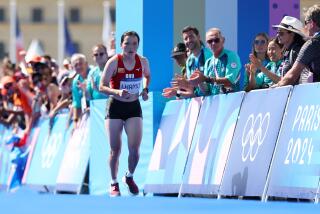ERASING BAD TIMES : Mary Slaney Hoping Today’s 3,000-Meter Race Is One to Remember
- Share via
For Mary Slaney, the time has come for another rendezvous with her Olympic destiny. That has usually meant bitter disappointment for her.
Going into Sunday’s 3,000-meter final (Saturday in Los Angeles), Slaney will, perhaps, have to battle an old demon--the specter of Zola Budd--but will have the benefit of an absent competitor, 1984 gold medalist Maricica Puica of Romania, who failed to finish her heat.
Even with all she has accomplished in her career, it has always been that which has been denied her that Slaney most covets--an Olympic medal. It is something, she has said, that “would have a very deep meaning for me.”
Slaney made it safely through the qualifying heats, barely. There was a frightening echo of 1984 in Friday’s qualifying heats.
With less than 2 laps left in the second of two heats, Annette Sergent of France clipped Slaney’s heel on the straightaway.
Obviously startled, Slaney, moved quickly to the side, momentarily breaking stride.
The brush with disaster, however, may have spurred her to go faster, so as to get away from the pack. She went on to finish with the fourth-fastest qualifying time, 8 minutes 44.15 seconds. “It just made me think of L.A. for a second there,” she said. “It was a little scary.”
But there were no tears, no bitterness after this race. Slaney seemed cheerful, relaxed and didn’t point an accusing finger. “I can’t say (who it was),” she said. “All I could see was a blue uniform.”
Slaney tangled feet with barefoot runner Budd, South African-born but competing for Great Britain, during the 1984 L.A. Games and fell during the 3,000 final. The sight of Slaney crumpled in the infield, crying and injured, has been one of the lasting images of the 1984 Games.
Slaney will face formidable competition in the final. Impressive in their heats were runners from the powerful Eastern Bloc: Tatyana Samolenko of the Soviet Union and Paula Ivan of Romania. Elly van Hulst of the Netherlands has beaten Slaney this year and will be in the final, as will Yvonne Murray of Britain. Wendy Sly of Britain, 1984 silver medalist, barely qualified.
The race figures to be a tactical battle. Slaney has the benefit of a strong finishing kick, but she is unaccustomed to running in a crowd and may find herself in trouble if she allows herself to be boxed in.
In a career plagued with injuries, Slaney has struggled to have her fitness levels coincide with the major meets. She did that at the first World Championships in 1983, when she completed a difficult double, winning the 1,500 and 3,000.
She will attempt that again in Seoul. And again, her fitness is in question. Slaney has not really run outdoors since 1985.
In 1986, she took the year off to have her daughter. Since then, Slaney has had surgery twice on her right Achilles tendon.
This year, Slaney was beaten soundly by van Hulst in a race at Zurich. It was the first time Slaney had lost a 3,000 final she had finished.
Recently, Slaney felt ill before she left for the Games. She discovered that she had a low-grade infection that was treated with antibiotics. She said she didn’t believe it would affect her.
“I’ve had really good workouts and I had a good 100-meter time trial before I left Eugene (Ore., her hometown) and my workouts in Chiba (Japan, site of the U.S. track team’s training camp) went extremely well,” she said. “So now I think I just need to rest and start racing hard.”
In the heat, she ran just hard enough to qualify, she said.
Slaney is the most versatile female runner ever in the U.S., if not the world. She holds every U.S. women’s track record from 800 to 10,000 meters, but at 30, she says the 3,000-meter final is the most important event in her career. “My career has been built on all those years between the Olympics, and not necessarily the Olympics. But the Olympics is very special, and it was something that I thought of when I was very young and I still think of.”
And yet, Slaney has had a disappointing relationship with the Games.
She sat at home in 1976, sidelined by chronic leg pain.
She sat at home again in 1980, because of the U.S. boycott.
And in 1984, perhaps at her peak, there was the collision with Budd.
So now, it’s 1988. Rendezvous time, once again.
More to Read
Go beyond the scoreboard
Get the latest on L.A.'s teams in the daily Sports Report newsletter.
You may occasionally receive promotional content from the Los Angeles Times.








